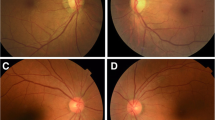Abstract
Background
Besides loss of visual acuity and binocularity, spatial localization deficits (comprising both increased spatial uncertainty and spatial distortions) are an important feature of strabismic amblyopia. Although they have been extensively investigated in adult amblyopes, there are still many open questions concerning their substrate and relationship to clinical parameters. Our aim was to develop a procedure for assessing vertical alignment, which enabled us to find out whether children with strabismic amblyopia had similar spatial localization deficits, and their relation to the children’s clinical condition.
Methods
Vertical alignment was assessed in children by comparing the visual direction in space of three loci along the vertical meridian, separated by 5 deg of visual angle. We tested alignment in the amblyopic and dominant eyes of 32 strabismic and in both eyes of 35 control children from 4.5 to 10 years, together with a careful orthoptic examination.
Results
In the amblyopic eyes, increased uncertainty and systematic distortions outside the normal range occurred. Large angles of deviation and pathological fixation patterns were necessary, but not sufficient conditions for gross spatial deficits to occur. The fellow dominant eyes showed spatial localization similar to normal eyes.
Conclusions
Children with strabismic amblyopia exhibited localization deficits and relationship to clinical data similar to those in adult amblyopes. These data are important for further investigations about the substrate, plasticity and the clinical relevance of perceptual distortions.







Similar content being viewed by others
References
Barrett BT, Pacey JE, Bradley A, Thibos LN, Morrill P (2003) Nonveridical visual perception in human amblyopia. Invest Ophthalmol Vis Sci 44:1555–1567
Bedell HE, Flom MC (1981) Monocular spatial distortion in strabismic amblyopia. Invest Ophthalmol Vis Sci 20:263–268
Bedell HE, Flom MC, Barbeito R (1985) Spatial aberrations and acuity in strabismus and amblyopia. Invest Ophthalmol Vis Sci 26:909–916
Burkhalter A (1993) Development of forward and feedback connections between areas V1 and V2 of human visual cortex. Cerebral Cortex 3:476–487
Burkhalter A, Bernardo KL, Charles V (1993) Development of local circuits in human visual cortex. J Neurosci 13:1916–1931
Cleary M, Thompson CM (2001) Diagnosis of eccentric fixation using a calibrated ophthalmoscope: defining clinically significant limits. Ophthalmic Physiol Opt 21:461–469
Crist RE, Kapadia MK, Westheimer G, Gilbert CD (1997) Perceptual learning of spatial localization: specificity for orientation, position, and context. J Neurophysiol 78:2889–2894
Demanins R, Hess RF (1996) Effect of exposure duration on spatial uncertainty in normal and amblyopic eyes. Vision Res 36:1189–1193
Flom MC (1991) Contour interaction and the crowding effect. Prob Optom 3:237–275
Freeman RD, Bradley A (1980) Monocularly deprived humans: nondeprived eye has supernormal vernier acuity. J Neurophysiol 43:1645–1653
Fronius M (2002) Amblyopietherapie in der Diskussion. Ophthalmologe 99:747–751
Fronius M, Sireteanu R (1989) Monocular geometry is selectively distorted in the central visual field of strabismic amblyopes. Invest Ophthalmol Vis Sci 30:2034–2044
Fronius M, Sireteanu R (1992a) Lokalisationsstörungen bei Schielamblyopen: horizontale Streckenteilung und vertikale relative Lokalisation. Klin Monatsbl Augenheilkd 201:22–29
Fronius M, Sireteanu R (1992b) Spatial localization errors in strabismic amblyopes: partitioning of horizontal lines and vertical alignment. Perception 21:39
Fronius M, Sireteanu R (1995) Distortions of visual space perception in strabismic amblyopia. Strabismus 3:43–45
Fronius M, Sireteanu R, Fuisting B, Zubcov A (1995) A test for assessing spatial localization in strabismic children. Perception: 24, 53
Fronius M, Zubcov A, Sireteanu R (1998) Spatial localization changes during occlusion therapy in children with strabismic amblyopia. Perception 27:161
Fronius M, Zubcov A, Sireteanu R, Büttner A (1999) Dynamics of spatial localization changes during occlusion therapy in children with strabismic amblyopia. Invest Ophthalmol Vis Sci 40 [Suppl]:307
Fronius M, Sireteanu R, Zubcov A, Büttner A (2000) Preliminary report: monocular spatial localization in children with strabismic amblyopia. Strabismus 8:243–249
Fuisting B, Haase W (1989) Gestörte relative Lokalisation bei Amblyopie vor und nach Behandlung. Z Prakt Augenheilkd 10:210–216
Gingras G, Mitchell DE, Hess RF (1999) The spatial localization deficit in visually deprived kittens. Invest Ophthalmol Vis Sci 40 [Suppl]:287
Haase W (1989) Amblyopie-Forschung unter klinischen Gesichtspunkten. Hamburger Ärztebl 10:375–382
Haase W, Hohmann A (1982) Ein neuer Test (C-Test) zur quantitativen Prüfung der Trennschwierigkeiten (“crowding”)—Ergebnisse bei Amblyopie und Ametropie. Klin Monatsbl Augenheilkd 180:210–215
Hess RF, Field DJ (1994) Is the spatial deficit in strabismic amblyopia due to loss of cells or an uncalibrated disarray of cells? Vision Res 24:3397–3406
Hess RF, Holliday IE (1992) The spatial localization deficit in amblyopia. Vision Res 32:1319–1339
Hess RF, Campbell FW, Greenhalgh T (1978) On the nature of the neural abnormality in human amblyopia: neural aberrations and neural sensitivity loss. Pflügers Arch 377:201–207
Hess RF, McIlhagga W, Field DJ (1997) Contour integration in strabismic amblyopia: sufficiency of an explanation based on positional uncertainty. Vision Res 37:3145–3161
Hess RF, Wang Y, Demanins R, Wilkinson F, Wilson H (1999) A deficit in strabismic amblyopia for global shape detection. Vision Res 39:901–914
Kiorpes L (1992) Effect of strabismus on the development of vernier acuity and grating acuity in monkeys. Vis Neurosci 9:253–259
Kiorpes L, Movshon JA (2002) Extended developmental time course for global visual functions in primates. J Vision 2(10): 47a
Kiorpes L, Kiper DC, O’Keefe LP, Cavanaugh JR, Movshon JA (1998) Neuronal correlates of amblyopia in the visual cortex of macaque monkeys with experimental strabismus and anisometropia. J Neurosci 18:6411–6424
Kovács I (2000) Human development of perceptual organization. Vision Res 40:1301–1310
Kovács I, Polat U, Pennefather PM, Chandna A, Norcia AM (2000) A new test of contour integration deficits in patients with a history of disrupted binocular experience during visual development. Vision Res 40:1775–1783
Lagrèze W, Sireteanu R (1991) Two-dimensional spatial distortions in human strabismic amblyopia. Vision Res 31:1271–1288
Lei H, Schuchard RA (1997) Using two preferred retinal loci for different lighting conditions in patients with central scotomas. Invest Ophthalmol Vis Sci 38:1812–1818
Levi DM, Klein SA (1985) Vernier acuity, crowding and amblyopia. Vision Res 25:979–991
Levi DM, Klein SA (2003) Noise provides some new signals about the spatial vision of amblyopes. J Neurosci 23:2522–2526
Levi DM, Klein SA, Yap YL (1987) Positional uncertainty in peripheral and amblyopic vision. Vision Res 27:581–597
Löwel S, Singer W (1992) Selection of intrinsic horizontal connections in the visual cortex by correlated neuronal activity. Science 255:209–212
McGraw P, Winn B, Whitaker D, McFazdean R (1998) Positional acuity in amblyopia: does a perceptual consequence of neural recruitment exist? Ophthalmic Physiol Opt 18:423–429
Noorden GK von (1990) Binocular vision and ocular motility. Mosby, St. Louis
Polat U, Sagi D, Norcia AM (1997) Abnormal long-range spatial interactions in amblyopia. Vision Res 37:737–744
Pugh M (1958) Visual distortion in amblyopia. Br J Ophthalmol 42:449–460
Rentschler I, Hilz R (1985) Amblyopic processing of positional information. I. Vernier acuity. Exp Brain Res 60:270–278
Roelfsema P, König P, Engel A, Sireteanu R, Singer W (1994) Reduced synchronization in the visual cortex of cats with strabismic amblyopia. Eur J Neurosci 6:1645–1655
Simmers AJ, Gray LS, McGraw PV, Winn B (1999) Functional visual loss in amblyopia and the effect of occlusion therapy. Invest Ophthalmol Vis Sci 40:2859–2871
Singer W (1995) Development and plasticity of cortical processing architectures. Science 270:758–764
Sireteanu R, Fronius M (1989) Different patterns of retinal correspondence in the central and peripheral visual field of strabismics. Invest Ophthalmol Vis Sci 30:2023–2033
Sireteanu R, Rieth C (1992) Texture segregation in infants and children. Behav Brain Res 49:133–139
Sireteanu R, Kellerer R, Boergen K-P (1984) The development of the peripheral visual acuity in human infants. A preliminary study. Hum Neurobiol 3:81–85
Sireteanu R, Lagrèze WD, Constantinescu DH (1993) Distortions in two-dimensional visual space perception in strabismic observers. Vision Res 33:677–690
Sireteanu R, Fronius M, Constantinescu DH (1994) The development of visual acuity in the peripheral visual field of human infants: Binocular and monocular measurements. Vision Res 34:1659–1671
Tychsen L, Burkhalter A, Wong A (2002) Paucity of horizontal connections for binocular vision within primary visual cortex of naturally-strabismic macaque. ARVO abstract
vom Hofe K (1930) Untersuchungen über das Sehen in Fällen von Schielamblyopie. Klin Monatsbl Augenheilkd 85:79
Yuodelis C, Hendrickson A (1986) A qualitative and quantitative analysis of the human fovea during development. Vision Res 26:847–855
Acknowledgements
Author M.F. was supported by grants from the Deutsche Forschungsgemeinschaft (Fr 1312/1-1 and 1-2). Thanks are due to Professors C. Ohrloff and W. Singer for support of this study, to the ophthalmologists and orthoptists who referred patients to our lab and made careful orthoptic examinations (PD Dr. D. Friedrich, Dr. U. Aschoff, M. Theisen, I. Bachert, A. Büttner-Cordey, H. Bartz, B. Herrmann, M. Murtro), and to our patients and their parents for their collaboration. We gratefully acknowledge the secretarial assistance of S. Klekar, help with statistics by Dr. Tews from the Biomathematics Department, and M. Mulvahill for language assistance.
Author information
Authors and Affiliations
Corresponding author
Rights and permissions
About this article
Cite this article
Fronius, M., Sireteanu, R. & Zubcov, A. Deficits of spatial localization in children with strabismic amblyopia. Graefe's Arch Clin Exp Ophthalmol 242, 827–839 (2004). https://doi.org/10.1007/s00417-004-0936-5
Received:
Revised:
Accepted:
Published:
Issue Date:
DOI: https://doi.org/10.1007/s00417-004-0936-5




